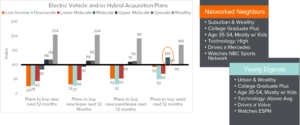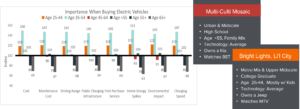
Capitalizing on the EV Market
Leveraging Segmentation, Multichannel Marketing, AI & Measurement
Fueled by environmental concerns, technological advancements, and shifting consumer preferences, the electric vehicle market is expected to grow at a compound annual growth rate of around 10% through 2028, with BloombergNEF estimating EV sales in 2024 of about 16.7 million vehicles. Cox Automotive also forecast that all-electric vehicles would account for over 10% of total vehicle sales in 2024, and 24% if you include hybrids. However, growth has slowed a bit, due to a variety of challenges facing the market including overall affordability, range anxiety, charging time, and availability of charging infrastructure.
As the automotive industry undergoes a significant transformation, businesses must adopt innovative marketing strategies to capitalize on the burgeoning EV market. Among these strategies, audience segmentation and multichannel marketing emerge as indispensable tools for reaching and engaging diverse consumer segments effectively.
Understanding the EV Landscape
Before delving into marketing strategies, it’s essential to grasp the evolving landscape of the EV market. Electric vehicles powered by clean energy sources contribute significantly to reducing greenhouse gas emissions, making them key in mitigating climate change and air pollution.
Government subsidies and policies that include excluding import, purchase, and road taxes for EVs, are augmenting the EV market. And while significant investments are being made in infrastructure to support EV sales, the differences in state policies has held back the expansion from occurring as fast as many wanted.
The EV market also faces manufacturing challenges and battery cost issues. EVs are more expensive than fossil fuel-based vehicles primarily due to the lack of economies of scale to-date and the high cost of batteries. However, as battery production scales up and more technological advancements are implemented, these costs are already declining. And with governments worldwide implementing stringent emissions regulations and offering incentives for electric vehicle adoption, consumer interest in EVs continues to rise. On the manufacturing side, technological advancements have enhanced the performance, range, and affordability of electric vehicles, making them increasingly attractive to a broader audience.
The Power of Audience Segmentation
Audience segmentation involves dividing a target market into distinct groups based on shared characteristics, behaviors, and preferences. In the context of the EV market, effective segmentation allows businesses to tailor their marketing efforts to specific consumer segments based on their concerns and preferences, and thereby maximize advertising relevance and sales. By understanding the unique needs of different customer segments, those marketing within the EV market can tailor their efforts to better meet them.
Claritas’ PRIZM® Premier is one of the most widely adopted segmentation solutions providing rich insights for every household in the U.S., including demographics, lifestyle and media preferences, shopping behaviors and technology usage. The PRIZM Premier audience segment that ranks the highest for plans to purchase or lease a new or used electric or hybrid vehicle in the next 12 months, is Networked Neighbors. And the segment most likely to already own an EV? Young Digerati. Both of these audience segments are listed as in the wealthiest of categories, indicating that cost is most definitely still a factor in the desire and/or ability to own electric vehicles.

That is further supported by looking at the plans for acquiring EVs by income category, as wealthy audience segments are 2X more likely to have plans to buy new or lease in the coming year. However, there was a significant increase in the midscale income category when plans were for purchasing used electric or hybrid vehicles.
PRO TIP: As prices of EVs continue to level out to those of combustion engine vehicles, additional opportunities will come about. Educational materials/advertising on financing and leasing options, as well as technologies that are advancing the affordability, could open up additional prospect categories more immediately.
Additional Segmentation Options
There are various approaches to audience segmentation, and selecting the most suitable one for your company is crucial. Syndicated or pre-built audience segments are generated from extensive consumer behavior and demographic data covering diverse categories like financial and technology preferences, multicultural affinity, and more. Essentially ready-made and easily actionable, Claritas’ syndicated audiences can be swiftly utilized across a network of 150 channel and platform partners and offers a cost-effective starting point for businesses aiming to target specific audience groups with shared attributes on a scalable level.
However, each business has its own unique marketing objectives, sometimes necessitating the targeting of very specific audiences. Custom segmentation involves crafting audiences from scratch through a modeling process, ideal for businesses with niche markets or precise marketing goals. Although custom segmentation may require more time and investment compared to off-the-shelf solutions, it offers unparalleled precision in targeting.
The choice between syndicated and custom segmentation depends on your company’s goals, resources, and audience characteristics. Claritas can help you determine the most effective option for reaching your specific goals.
Expansion Through Multichannel Marketing and the Advent of AI
Multichannel marketing involves engaging consumers across various channels, including digital platforms, social media, traditional advertising, and content marketing. By leveraging multiple touchpoints, businesses can amplify their reach and impact, effectively communicating their value proposition to diverse audience segments.
Once you know the audience segments that are your best customers or prospects, a successful multichannel marketing strategy includes knowing which media channels and what messaging will be the most effective. What social media do your key prospects prefer? Do they listen to radio, podcasts or watch specific CTV? Are print media and email marketing still effective channels? Discovering the answers to these questions tells you where to place key advertising and marketing content.
For instance, Networked Neighbors ranks high for watching NBC Sports Network and listening to Stanley Cup playoffs. And when researching cars, they rank highest for TrueCar, Edmunds and various auto manufacturer’s websites.
PRO TIP: While these media sites might be the natural place to start, it is also prudent to target audience segments that are adjacent to Network Neighbors, or who are on the upswing in their feelings towards the EV market. Look for upscale suburbanites with longer commuting distances and strong sustainability/environmental tendencies, and research their top media channels as a way to expand beyond traditional prospects.
Knowing the messaging to use when targeting customers and prospects is another key data strategy point. Why they are considering purchasing (or NOT purchasing) electric and hybrid vehicles, is key.
There are several things to note in the below chart. First it is clear that those in the age 35 – 54 segment, are clearly the driving force in electric vehicle interest. Both Networked Neighbors and Young Digerati fall in this age bracket.

Second, the interest in all categories seems to be relatively stable across all criteria – for instance, the importance of buying within the 35-54 age group ranges only from an index of 145 – 151. However, there are some notable exceptions. PRIZM Premier segment, Bright Lights, Li’l City indexed at 164 for “Home Energy Spikes” and 163 for “Environmental Impact”, but only 150 for “Cost”. And the segment Multi-Culti Mosaic indexed 129 for “Environmental Impact” and only 110 for “Cost”. For these segments, which are available and ready to be used across all major platforms, emphasis on the environmental impacts of EVs would be ideal (including in-language versions).
Clearly there is a range of what many consumers are interested in and/or concerned about when it comes to EVs. This is a perfect opportunity for the use of new AI technology that allows you to reach these different groups with more specific, personalized messaging that speaks directly to their needs.
Claritas AI Personalization – Ensure you deliver the right message to the right audience
AI personalization brings together two dynamic elements that influence a consumers’ response: message & context. Content creation yields hundreds of thousands of different creative versions and learns which message elements work best for different audiences in different contexts. It allows you to create a dynamic, personalized customer journey.
As an example, General Motors was looking to increase website visits for the Chevrolet Silverado using a robust video advertising campaign. Using Claritas’ AI Personalization, GM was able to enhance content relevance and optimize engagement based on the target audience profile. The result was 243 variations of creative ad material and a 68% increase in webpage visits! Read the full case study here.
Harnessing Data for Continuous Optimization
Central to the success of audience segmentation and multichannel marketing is the ongoing collection and analysis of data and campaign performance. By leveraging data and analytics, businesses can gain actionable insights into consumer behavior, campaign performance, attribution, and market trends. Continuously optimizing marketing strategies based on real-time data allows for greater agility and effectiveness in reaching target audiences.
At Claritas we unify devices, conversion environments and precise measurement indicators to analyze the effectiveness of utilized media and the audiences they’re reaching. Our cross-device and cross-environment attribution integrates impressions across digital display, OTT/CTV, streaming audio, podcast, direct mail, mobile and out-of-home, providing you with an accurate and transparent analysis of which channels are most effective at converting. This allows you to optimize campaigns and continually improve ROI by understanding which tactics are the most effective in leading to both online and offline conversions across the consumer purchasing journey.
Conclusion
As the EV market continues to expand and evolve, businesses must adopt a strategic approach to marketing that prioritizes audience segmentation and multichannel engagement. By understanding the diverse needs, preferences, and behaviors of potential EV buyers and deploying targeted campaigns across multiple channels, companies can position themselves for success in this dynamic and competitive landscape. Embracing innovation, leveraging data-driven insights, and prioritizing customer-centricity are key to capitalizing on the immense opportunities presented by the electric vehicle revolution.
